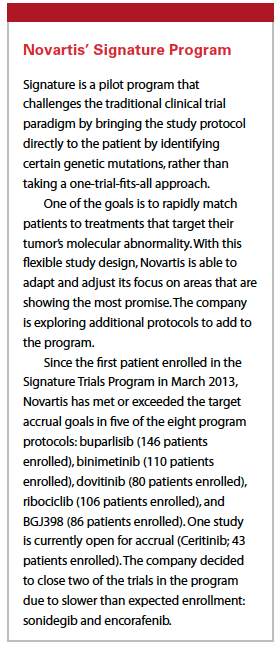Following the Science
Bill Hinshaw, Executive VP and Head of Novartis Oncology US, talks about the company’s efforts to create innovation in the cancer arena.
PV: What is Novartis doing to encourage innovation?
Hinshaw: Transforming cancer care is a core part of our mission. Novartis as a corporation, meaning beyond oncology, believes in both global scale innovation and power. In oncology specifically, our mantra is to follow the science. This goal has allowed us to create a very productive research and development organization.
 More recently, we’ve extensively expanded into the area of immuno-oncology, where we see a tremendous opportunity to transform cancer care in the future with combinations of both targeted and nontargeted therapies.
More recently, we’ve extensively expanded into the area of immuno-oncology, where we see a tremendous opportunity to transform cancer care in the future with combinations of both targeted and nontargeted therapies.
Open collaboration and sharing information is really important to Novartis, because the science in oncology is exploding. There are wonderful opportunities and there’s never been a more exciting time. At the same time, there are so many options or permutations of these combinations that we have to work with the broader community and share information.
By open collaboration, I mean innovating across the medical community, not only with our own scientists, but also with other scientists throughout the industry, as well as with academic centers and scientific labs. Where appropriate, we look to define specific collaborations, for instance, evaluating animal models in immuno-oncology, which is a current gap. For example, currently, a human immune response can’t be evaluated in animal models the same way as in other areas, so we’re collaborating to address this challenge to unlock the potential of immune-oncology.
There is an overarching amount of data and information that’s coming out right now. Since the end of 2013, the amount of data that has been generated is greater than the total amount of information generated in history before 2013. With that pace of information, we need to set standards, work together, and continue to share information to address big scientific questions.
PV: How is Novartis transforming the clinical trial process?
Hinshaw: Our Signature Program — an innovative development strategy — is a signal finding platform where we employ a tissue-agnostic and site-agnostic approach to developing and answering important clinical questions.
 We are looking at a series of potential mutations, in this case across 10 to 12 different areas. We do not open a site unless there is an eligible patient for the trial. Once a patient with a certain mutation has been identified, the site submits the lab and patient information into a call center, and then we determine whether or not the patient meets the right criteria. This approach allows us to move much faster. What’s really important about this model is it helps us identify signals — hence the name Signature.
We are looking at a series of potential mutations, in this case across 10 to 12 different areas. We do not open a site unless there is an eligible patient for the trial. Once a patient with a certain mutation has been identified, the site submits the lab and patient information into a call center, and then we determine whether or not the patient meets the right criteria. This approach allows us to move much faster. What’s really important about this model is it helps us identify signals — hence the name Signature.
The program began in 2013-2014 and has been used across eight different study programs. We’ve had more than 600 patients participate, and we will continue to evolve the program going forward.
The average study start-up time using this approach is four weeks. Typically, a study start up involves a long process — from protocol review to site visits, to IRB plans, to budgeting, etc. With Signature, we’ve been able to cut off more than 30 weeks on average against that. Also, on average we have been able to accrue patients more quickly than a traditional trial structure.
PV: What factors do you think are important to create an innovation-focused organization?
Hinshaw: No. 1 is talented people. We have more than 6,000 scientists at Novartis Institutes for BioMedical Research (NIBR), as well as all of our associates who interface with the customers and patients. They understand not only the scientific needs, but patient and system needs, which are fundamentally critical to success.
Next, is the environment that we create, as well as the strategy and the resource and organizational structures. NIBR was created as a distinct research platform, where our researchers follow the science, mechanisms, and pathways. We have institutions around the world — Asia, Europe, and North America. For example, we have a group in La Jolla, Calif., called GNF that is pursuing big strategies and these researchers have helped develop 12 different products over the years.
Our process evaluates the portfolio from end to end and looks at the unmet medical need, patient opportunity, and the science and pathways.
We can then facilitate process-oriented decision making and support the great opportunities that have led to a very productive pipeline.
The critical question of course is, does this process make a difference for patients? And this is where our end-to-end view comes into play and how we work with the sites and the impact this has on patients. We are also focusing our pipeline and our research efforts in five core disease areas: lung cancer, breast cancer, melanoma, renal diseases, and hematology. This scientific focus allows us to go deeper into these diseases beyond a single line of therapy or mechanism of delivery and allows us to look at how we can help patients across a continuum of a disease, which is where we have the opportunity to continue to innovate. (PV)



















